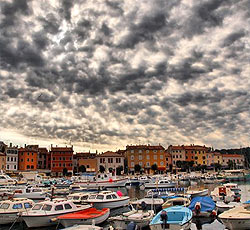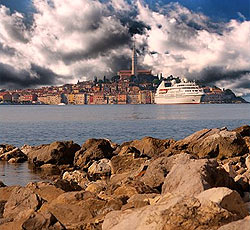-
"Crveni Otok" Red Island (Rovinj, Istria)
For those who are interested to explore Rovinj and its beautiful surrounding there is an island Crveni otok where is located an interesting Institute of Marine Biology. The island actually consist of two islands named St. Andrew and Maškin.
Red Island Info -
Lim valley (Rovinj, Istria)
The Lim valley (Limska draga or Limska dolina) is the 35 km long valley of the river Pazinčica, which transforms into the Lim bay (Limski zaljev), a 10 kilometer long estuary. Lim Bay got its name from the Latin word limes meaning border because the bay was a natural border between the two Roman provinces. The Croats sometimes call it Limski kanal (Lim Channel), due to its narrow width. The estuary is sometimes called a fjord, even if it is not in fact a fjord but a ria, because it was not carved by a glacier but by the river eroding the ground on its way to the Adriatic Sea.
Lim Info -
The Grisija (Rovinj, Istria)
Surely among the most known trademarks of ancient Rovinj, Grisija is a picturesque cobbled and sprial street with playful shiny stone pillars. -
Forest park Punta Corente (Zlatni Rt) (Rovinj, Istria)
Golden Cape (Zlatni rt/Punta corrente), Kurent Bay and Montauro Cape are situated around 1.5 km away from the town-center, south of the ACI Marina and Lone Bay. The coast is rocky for the most of the part. There are a few beaches covered with small round stones, and Kurent Bay, the most visited beach in this area, covered with gravel.
Punta Corente Info -
Monfiorenzo cave (Rovinj, Istria)
Near the road Rovinj-pula, about 2 kilometers far from the centre of the City of Rovinj, in the locality of Monfiorenzo, is located the quarry phantasy, a geological parc of extraordinary beauty and importance. According to expert opinion of many scientists, it is one of the most significant nature landmarks in the world regarding the karst phenomenon. The lime-stone of the quarry phantasy, give evidence for the history of the evolution of the terrestrial crust.
Monfiorenzo cave Info -
The Palud Marsh And The Dvije Sestrice Islands (Rovinj, Istria)
The Palud cove, 8 kilometres southwest of Rovinj, is the only ornithological park in Istria. Palud is a natural depression quite close to the sea, which because of the inflow of water from the surrounding hills and uplands, as well as springs on the northern side has transformed into a swamp.
Palud Marsh Info
Rovinj - przewodnik turystyczny na wakacje w Rovinj na Istrii
Rovinj – Historyczne
 Rovinj, stare, ale popularne miasto rybackie otoczone wyspami i wysepkami, znajduje się na zachodnim wybrzeżu Istrii i jest jednym z najbardziej rozwiniętych nadmorskich kurortów w Chorwacji. Rovinj jest ważnym historycznym i kulturalnym centrum Istrii. Stare miasto leży na stożkowatym przyladku, które do 1763 r. było częścią przybrzeżnej wysepki. W XVIII w. Rovinj zostało wypełnione kontynentem. W XVIII w. Rovinj był najbardziej zaludnionym miastem w Ventian, części Istrii po Kopar.
Rovinj, stare, ale popularne miasto rybackie otoczone wyspami i wysepkami, znajduje się na zachodnim wybrzeżu Istrii i jest jednym z najbardziej rozwiniętych nadmorskich kurortów w Chorwacji. Rovinj jest ważnym historycznym i kulturalnym centrum Istrii. Stare miasto leży na stożkowatym przyladku, które do 1763 r. było częścią przybrzeżnej wysepki. W XVIII w. Rovinj zostało wypełnione kontynentem. W XVIII w. Rovinj był najbardziej zaludnionym miastem w Ventian, części Istrii po Kopar. Miasto jest starożytną osadą sławną setki lat temu, gdy starzy Grecy i Rzymianie walczyli o te tereny i pozostawili tu swoje ślady. Miasto zostało po raz pierwszy wspomniane w VII wieku jako Castrum Rubini. Rzymianie zbudowali port na wyspie, która w roku 1763 została włączona do kontynentu. W ciągu kolejnego stulecia, populacja Rovinj zawsze poszukiwała ochrony św. Eufemii. Poświęcona świętej katedra dominuje nad miastem i chroni je. Inne ważne skarby to: Stare Miasto, Barokowy Magistrat, Kaplica św. Trójcy, Klasztor Franciszkański, Zamek na wyspie św. Andrzeja i wiele innych. Bezcennym zabytkiem jest "Seven Old Town Gates" (Siedem Bram Starego Miasta), z których tylko trzy bramy zachowały oryginalny kształt: Brama św. Benedykta, Brama pod Murem i Brama Św. Krzyża.




